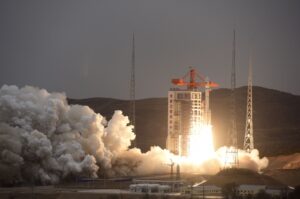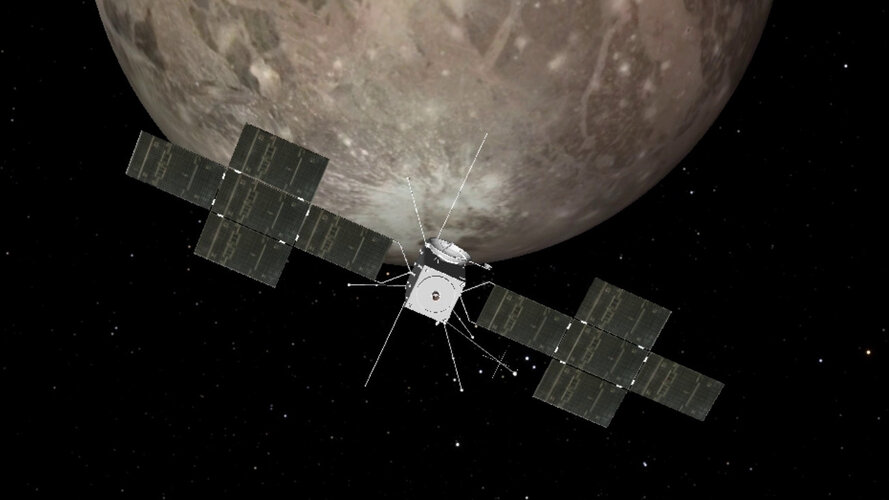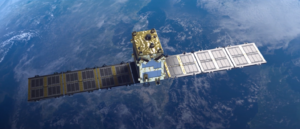Astronomy's ten-year wish list: Big money, bigger telescopes and the biggest questions in science
Tuesday, 29 March 2022 11:24
It takes expensive tools to learn about the universe, but projects like the Very Large Array for radio astronomy in New Mexico and the Chandra X-ray Observatory, which orbits Earth, have pushed scientific knowledge forward in ways that would not have been possible without these instruments. Every 10 years, astronomers and astrophysicists outline priorities for the hardware they need in the decadal survey on astronomy and astrophysics.
China launches first Long March rocket with solid boosters
Tuesday, 29 March 2022 11:22
China launched its first Long March 6A from a new launch complex at Taiyuan Tuesday, successfully sending two satellites into sun-synchronous orbits.
The post China launches first Long March rocket with solid boosters appeared first on SpaceNews.
Juice’s journey and Jupiter system tour
Tuesday, 29 March 2022 11:00 Video:
00:04:25
Video:
00:04:25
ESA’s Jupiter Icy Moons Explorer, Juice, is set to embark on an eight-year cruise to Jupiter starting April 2023. The mission will investigate the emergence of habitable worlds around gas giants and the Jupiter system as an archetype for the numerous giant planets now known to orbit other stars.
This animation depicts Juice’s journey to Jupiter and highlights from its foreseen tour of the giant planet and its large ocean-bearing moons. It depicts Juice’s journey from leaving Earth’s surface in a launch window 5–25 April 2023 and performing multiple gravity assist flybys in the inner Solar System, to
Synspective raises $100 million Series B round
Tuesday, 29 March 2022 10:00
Japanese startup Synspective announced March 29 it raised $100 million to continue its development of a constellation of synthetic aperture radar (SAR) satellites.
The post Synspective raises $100 million Series B round appeared first on SpaceNews.
X-BOW Systems unveils 3D Printed solid rocket motors
Tuesday, 29 March 2022 07:30 X-Bow Launch Systems Inc. (X-Bow), a revolutionary American space technology company focused on 3D printed energetics, reports that it has exited stealth mode. X-Bow (pronounced "cross-bow") brings to market its solid fuel rocket motors, along with a suite of small launch vehicles for both orbital and suborbital launch services. Customers already include the U.S. Air Force Research Labs and AFWE
X-Bow Launch Systems Inc. (X-Bow), a revolutionary American space technology company focused on 3D printed energetics, reports that it has exited stealth mode. X-Bow (pronounced "cross-bow") brings to market its solid fuel rocket motors, along with a suite of small launch vehicles for both orbital and suborbital launch services. Customers already include the U.S. Air Force Research Labs and AFWE SENER completes hard capture system for universal docking mechanism
Tuesday, 29 March 2022 07:30 SENER Aeroespacial has developed the Hard Capture System (HCS) for the IBDM (International Berthing and Docking Mechanism), which is the European androgynous low impact docking system that allows both large and small spacecraft to berth and dock.
SENER Aeroespacial takes part in the IBDM as part as the European consortium, developing the HCS. It is an extremely precise and complex system w
SENER Aeroespacial has developed the Hard Capture System (HCS) for the IBDM (International Berthing and Docking Mechanism), which is the European androgynous low impact docking system that allows both large and small spacecraft to berth and dock.
SENER Aeroespacial takes part in the IBDM as part as the European consortium, developing the HCS. It is an extremely precise and complex system w Omnispace and Nelco announce strategic partnership
Tuesday, 29 March 2022 07:30 Omnispace and Nelco Limited, a TATA Group company, have announced a strategic cooperation agreement to enable and distribute 5G non-terrestrial network (NTN), direct-to-device satellite services. The collaborative effort will expand the reach of 5G using satellite communication throughout India and South Asia.
Nelco provides satcom services to enterprise customers for business-critical app
Omnispace and Nelco Limited, a TATA Group company, have announced a strategic cooperation agreement to enable and distribute 5G non-terrestrial network (NTN), direct-to-device satellite services. The collaborative effort will expand the reach of 5G using satellite communication throughout India and South Asia.
Nelco provides satcom services to enterprise customers for business-critical app Neuraspace raises funding to prevent satellite collisions
Tuesday, 29 March 2022 07:30 Neuraspace, the developer of an advanced AI-powered Space debris monitoring and satellite collision avoidance platform, has raised euro 2.5 million from Armilar Venture Partners. The company will use these funds to accelerate the commercialisation of its platform.
Neuraspace's proprietary AI technology enables more accurate satellite collision risk prediction and, by applying a data fusio
Neuraspace, the developer of an advanced AI-powered Space debris monitoring and satellite collision avoidance platform, has raised euro 2.5 million from Armilar Venture Partners. The company will use these funds to accelerate the commercialisation of its platform.
Neuraspace's proprietary AI technology enables more accurate satellite collision risk prediction and, by applying a data fusio Kymeta signs agreement with OneWeb to sell connectivity services
Tuesday, 29 March 2022 07:30 Kymeta has announced a distribution partner agreement to offer broadband connectivity services across the globe. The OneWeb LEO satellite network will give Kymeta customers access to high-speed, low-latency broadband connectivity while on the move or while stationary, anywhere in the world.
Kymeta offers the world's only high-bandwidth, low power, fully integrated family of high throughput
Kymeta has announced a distribution partner agreement to offer broadband connectivity services across the globe. The OneWeb LEO satellite network will give Kymeta customers access to high-speed, low-latency broadband connectivity while on the move or while stationary, anywhere in the world.
Kymeta offers the world's only high-bandwidth, low power, fully integrated family of high throughput Astronomy's 10-year wish list
Tuesday, 29 March 2022 07:30 It takes expensive tools to learn about the universe, but projects like the Very Large Array for radio astronomy in New Mexico and the Chandra X-ray Observatory, which orbits Earth, have pushed scientific knowledge forward in ways that would not have been possible without these instruments.
Every 10 years, astronomers and astrophysicists outline priorities for the hardware they need in the
It takes expensive tools to learn about the universe, but projects like the Very Large Array for radio astronomy in New Mexico and the Chandra X-ray Observatory, which orbits Earth, have pushed scientific knowledge forward in ways that would not have been possible without these instruments.
Every 10 years, astronomers and astrophysicists outline priorities for the hardware they need in the Surface simulation lab launches new chapter in Australian space research
Tuesday, 29 March 2022 07:30 the University of Adelaide launched its new Exterres Laboratory. The lab, which is the first of its kind in Australia, is an off-Earth surface testing environment for space technology like rovers, which are destined for the furthest reaches of the universe.
The Extraterrestrial Environmental Simulation (Exterres) Laboratory, located on North Terrace campus, provides a crucial stepping st
the University of Adelaide launched its new Exterres Laboratory. The lab, which is the first of its kind in Australia, is an off-Earth surface testing environment for space technology like rovers, which are destined for the furthest reaches of the universe.
The Extraterrestrial Environmental Simulation (Exterres) Laboratory, located on North Terrace campus, provides a crucial stepping st SES adds satellite to extend services across Europe, Africa and Asia
Tuesday, 29 March 2022 07:30 SES has ordered SES-26 a fully software-defined geostationary (GEO) satellite from Thales Alenia Space, joint venture between Thales (67 %) and Leonardo (33 %). SES-26 will maintain and expand the wide range of content delivery and connectivity services to broadcasters, media companies, telco operators, internet service providers and governmental organisations across Europe, Africa, the Middle E
SES has ordered SES-26 a fully software-defined geostationary (GEO) satellite from Thales Alenia Space, joint venture between Thales (67 %) and Leonardo (33 %). SES-26 will maintain and expand the wide range of content delivery and connectivity services to broadcasters, media companies, telco operators, internet service providers and governmental organisations across Europe, Africa, the Middle E Momentus' Vigoride vehicle completes thermal vacuum testing
Tuesday, 29 March 2022 07:30 Momentus Inc. (NASDAQ: MNTS), a U.S. commercial space company that plans to offer transportation and other in-space infrastructure services, recently completed Thermal Vacuum Testing (TVAC) on its Vigoride vehicle in preparation for its inaugural mission.
Thermal vacuum testing allows for the simulation of space conditions, including the temperature and altitude that the Vigoride spacecraf
Momentus Inc. (NASDAQ: MNTS), a U.S. commercial space company that plans to offer transportation and other in-space infrastructure services, recently completed Thermal Vacuum Testing (TVAC) on its Vigoride vehicle in preparation for its inaugural mission.
Thermal vacuum testing allows for the simulation of space conditions, including the temperature and altitude that the Vigoride spacecraf Researchers earn NASA grant to reinvent electronics manufacturing in space
Tuesday, 29 March 2022 07:30 Manufacturing electronics and sensors in space are becoming an inevitable part of future space exploration and activities. But even today's state-of-the-art liquid-based printing machines present challenges within microgravity or antigravity environments. That's a problem.
A team of Auburn multi-disciplinary researchers, however, have a proposed solution.
Masoud Mahjouri-Samani, assi
Manufacturing electronics and sensors in space are becoming an inevitable part of future space exploration and activities. But even today's state-of-the-art liquid-based printing machines present challenges within microgravity or antigravity environments. That's a problem.
A team of Auburn multi-disciplinary researchers, however, have a proposed solution.
Masoud Mahjouri-Samani, assi Next steps for ExoMars with the rover ready
Tuesday, 29 March 2022 07:30 The ESA-led Rosalind Franklin rover has a unique potential to search for evidence of past life on Mars thanks to its drill and laboratory. It will be the first rover to drill 2 m below the surface, and the first to use novel driving techniques, including wheel-walking, to overcome obstacles.
Although the 2022 launch window for the mission is no longer possible following the suspension of c
The ESA-led Rosalind Franklin rover has a unique potential to search for evidence of past life on Mars thanks to its drill and laboratory. It will be the first rover to drill 2 m below the surface, and the first to use novel driving techniques, including wheel-walking, to overcome obstacles.
Although the 2022 launch window for the mission is no longer possible following the suspension of c 
